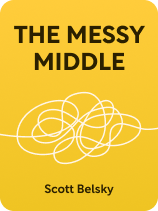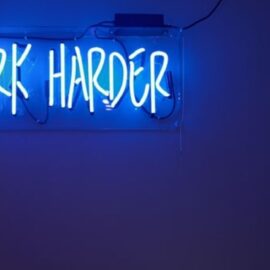

This article is an excerpt from the Shortform book guide to "The Messy Middle" by Scott Belsky. Shortform has the world's best summaries and analyses of books you should be reading.
Like this article? Sign up for a free trial here.
Why does building a successful business take so much longer than most people expect? What can keep you motivated when traditional success metrics don’t show immediate results?
Growing a business requires patience, curiosity, and internal motivation. In The Messy Middle, Scott Belsky explores how entrepreneurs can maintain their tenacity through the long journey toward success, offering practical strategies to stay energized when external validation is scarce.
Keep reading to discover how tenacity in business can transform your entrepreneurial journey.
Why Growing a Business Requires Tenacity
The highs and lows of the road to success aren’t the only struggles you’re going to face as you build your business. According to Belsky, the chief factor that makes growing a business so difficult is the sheer amount of time it takes. Surmounting this barrier takes determination. He discusses what tenacity in business look like, including a great deal of patience and a curious mind that can find its own rewards in the midst of the process long before you reach the end.
Belsky argues that short-term thinking is only natural, which makes it hard to focus on long-term goals and strategies. That’s why enduring the challenges of growing a startup requires tremendous fortitude. However, to sustain your momentum over the long haul, you can’t rely on personal praise, good reviews, or even other people’s understanding. Though it’s only natural to crave those things, not getting noticed for all your hard work could easily frustrate you and cloud your judgment if that’s your only motive for success. Therefore, Belsky says that, instead of relying on external validation, your motivation must come from within.
(Shortform note: Belsky’s advice to create your own motivation may sound hard to do, but in The Art of Impossible, Steven Kotler points out that from a brain science perspective, achieving intrinsically motivated goals generates more pleasurable neurochemicals than achieving goals tied to external motivation. The trick is to identify what your internal motivations are and align them with the goals of your business. Kotler recommends exploring your personal interests and finding ways to link them together. You should also expand your social network to include people whose goals complement yours to engage a positive feedback cycle of social support and mutually motivated progress, whether in business or your personal life.)
To endure the long stretch between beginning a project and seeing it succeed, you’ll need a lot of patience. Belsky points out that many business success stories ignore the need for patience, giving entrepreneurs unrealistic expectations, when some seemingly “overnight” successes come after years of persistence. While you may have conceived your business strategy quickly, it can only be carried out over a long time. Therefore, you need to adjust your expectations and how you measure your company’s progress.
(Shortform note: Though your urge may be to push yourself and your team to get results as soon as possible, the best way to cultivate the long-term patience that Belsky recommends may be for you to slow down. In The Ruthless Elimination of Hurry, pastor John Mark Comer argues that when your life is lively, it brims with meaningful purpose, but when you’re merely busy, the work overwhelming you is probably meaningless, and you need to cut back and be patient with your progress. He suggests that if this is hard, you can gamify patience—in other words, turn slowing down into a game. For instance, make a game of reducing your meaningless phone use by creating rules for when and how to use it and challenging yourself to follow them.)
The problem is that traditional measures of business success, such as earnings or profits, don’t leave room for patience on your quarterly income statement, so you’ll have to be creative with how you measure progress. Especially if your goal is far away, such as making a new type of business viable, traditional metrics such as short-term profits won’t suffice. Instead, Belsky says you should determine the most appropriate way to measure the steps that bring you closer to your goal, and use those to validate yourself and your team’s progress while you patiently wait for profits that might not materialize for years.
(Shortform note: The most conventional way people use to determine success is to measure results, but to be more creative, as Belsky suggests, you should consider tracking your efforts instead. The authors of The 4 Disciplines of Execution argue that past results don’t give you any information on how to proceed. If you track your current efforts—or “lead measures,” as they call them—you’ll find them a much more effective guide. Lead measures are predictive and influenceable, in that a change in your efforts yields a change in results. For instance, if you’re trying to save money, you can focus on working more and spending less (efforts) instead of dwelling on how much your expenses were in the past.)
Belsky suggests that curiosity can keep you on track when traditional metrics such as profits aren’t available. He argues that, when you and your team work from a position of curiosity—such as whether a solution to a problem will work or if there are potential customers you haven’t considered—you won’t think about day-to-day success the same way that traditional businesses do. You might explore partnerships that aren’t obviously beneficial but lead to valuable connections in the future, or you may invest time in projects that don’t provide short-term payoffs but show potential for future success. Belsky says that if you find satisfaction in the learning process, you can stay energized when the road ahead seems never-ending.
| Questions to Shape Your Progress If Belsky’s description of curiosity seems open-ended and vague, journalist Warren Berger offers more specific guidelines in A More Beautiful Question. Berger suggests that business leaders should always be asking fundamental questions, such as: • Why do some people choose our competitors instead of us? • Why not try to reach a new demographic? How could we do that? • What if we updated our mission statement to better reflect today’s values? • What if a new startup disrupts our market, as Uber did to taxis? • Why not let our employees work from home? Berger asserts that the most successful companies are those that encourage employees to ask questions and search for innovative answers. To foster curiosity throughout your organization, Berger says to replace brainstorming sessions with question-storming sessions in which employees are asked to come up with questions instead of ideas. Since there’s no pressure to answer those questions right away, these sessions help people’s thoughts flow freely, without the urge to censor themselves. In Belsky’s “messy middle” of company growth, these sessions would also keep workers energized and promote continued engagement. |
Exercise
Belsky describes the middle period of any business venture, whether it’s an entrepreneurial startup or a project within a larger business, as a maze of setbacks and successes. The same could be said for any project in life, such as finishing your education or mastering a new skill. Think about a long-term project you’ve engaged in, whether in your professional or personal life, and what the road was like between the start and finish. How long did it take for your initial sense of energy and excitement to wear off? Once it did, describe the feelings that replaced it.

———End of Preview———
Like what you just read? Read the rest of the world's best book summary and analysis of Scott Belsky's "The Messy Middle" at Shortform.
Here's what you'll find in our full The Messy Middle summary:
- A gravely overlooked aspect of being an entrepreneur
- The skills you need to keep your startup business afloat
- Why the middle part of starting a business is the most important






